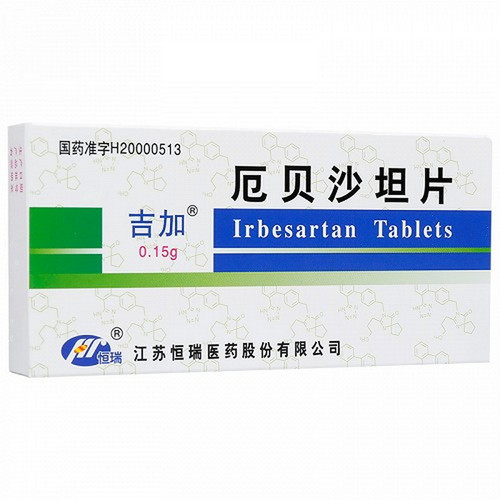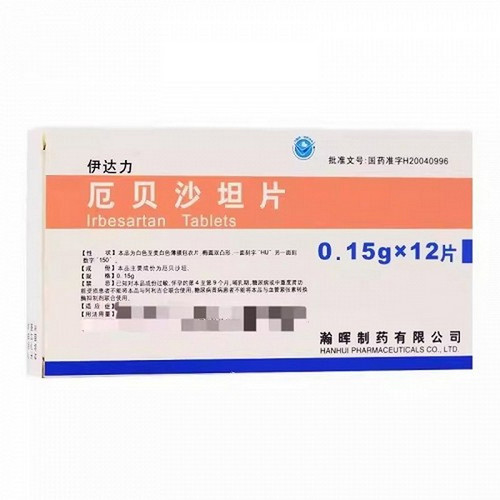Product Overview
[Drug Name]
Generic Name: Irbesartan Tablets
Trade Name: Anbowei
English Name: Ebeishatan Pian
Chinese Pinyin: Ebeishatan Pian
[Ingredients]
Irbesartan 0.15g. Molecular Weight: C25H28N6O
[Appearance]
White biconvex oval tablets with a heart-shaped notch on one side and 2872 engraved on the other side.
[Indications]
Treatment of essential hypertension and type 2 diabetic nephropathy with hypertension.
[Dosage and Administration]
The recommended initial and maintenance dose is 150 mg daily. Dietary considerations are not recommended. Generally, 150 mg of irbesartan once daily provides better 24-hour blood pressure control than 75 mg. However, for certain patients, particularly those undergoing hemodialysis and those over 75 years of age, a 75 mg initial dose may be considered. For patients whose blood pressure is not effectively controlled with 150 mg of irbesartan once daily, the dose can be increased to 300 mg or other antihypertensive medications can be added. In particular, the addition of diuretics such as hydrochlorothiazide has been shown to have an additive effect. In hypertensive patients with type 2 diabetes, the initial treatment dose should be 150 mg once daily, titrated up to 300 mg once daily as a maintenance dose for renal disease.
Adverse Reactions
The incidence of adverse reactions listed below is defined using the following conventions: very common (≥1/10); common (≥1/100); uncommon (≥1/1000, <1/100); rare (≥1/10000, <1/1000); and very rare (<10000). For use in hypertension: In placebo-controlled trials in patients with hypertension, the overall incidence of adverse events did not differ between the irbesartan group (56.2%) and the placebo group (56.5%). The incidence of treatment discontinuation due to clinical or laboratory adverse events was lower in the irbesartan group (3.3%) than in the placebo group (4.5%). Adverse events were not related to dose (within the recommended dose range), sex, age, race, or treatment duration. In placebo-controlled trials, 1,965 patients received irbesartan, and the following adverse drug reactions were reported: Nervous system disorders - Common: Dizziness; Cardiac disorders - Uncommon: Tachycardia; Vascular disorders - Uncommon: Flushing; Respiratory, chest, and diaphragmatic disorders - Uncommon: Cough; Gastrointestinal disorders - Common: Nausea/vomiting; Uncommon: Diarrhea, dyspepsia/heartburn; Reproductive system and breast disorders - Uncommon: Sexual dysfunction; Systemic disorders and administration site conditions - Common: Fatigue; Uncommon: Chest pain; Examination: Common: Significant increases in plasma creatine kinase levels were observed in the irbesartan treatment group (1.7%), but none of these increases were associated with clinically recognizable skeletal muscle events. Hypertension and type 2 diabetes mellitus with renal disease: In addition to the adverse drug reactions mentioned under hypertension, orthostatic dizziness and orthostatic hypotension were reported in 0.5% (uncommon) of diabetic hypertensive patients with microalbuminuria and normal renal function, exceeding the placebo group. In diabetic hypertensive patients with chronic renal insufficiency and significant proteinuria, the following adverse reactions were reported in 12% of patients, exceeding the placebo group. Neurologic disorders - Common: orthostatic dizziness; Vascular disorders - Common: orthostatic hypotension; Skeletal muscle, connective tissue, and bone disorders - Common: musculoskeletal pain; Examination: The incidence of hyperkalemia in diabetic patients treated with irbesartan was higher than that in the placebo group. Among diabetic hypertensive patients with microalbuminuria and normal renal function, hyperkalemia (≥5.5 mEq/L) occurred in 29.4% (very common) of patients taking irbesartan 300 mg compared to 22% of patients taking placebo. Among diabetic hypertensive patients with chronic renal insufficiency and significant proteinuria, hyperkalemia (≥5.5 mEq/L) occurred in 46.3% (very common) of patients receiving irbesartan 300 mg, compared to 26.3% of patients receiving placebo. Among hypertensive patients with progressive diabetic nephropathy treated with irbesartan, hemoglobin decreases occurred in 1.7% (common), but were not clinically significant. Furthermore, the following adverse reactions have been reported since the marketing of irbesartan: Immune system disorders - rare: As with other angiotensin II receptor antagonists, hypersensitivity reactions such as rash, urticaria, and angioedema have occurred in a small number of cases. Metabolic and Nutritional Disorders - Very rare: Hyperkalemia; Neurological Disorders - Very rare: Headache; Ear and Labyrinthine Disorders - Very rare: Tinnitus; Gastrointestinal Disorders - Very rare: Anorexia; Hepatobiliary Disorders - Very rare: Liver function abnormalities, hepatitis; Skeletal Muscle, Connective Tissue, and Bone Disorders - Very rare: Myalgia, arthralgia; Renal and Urinary Tract Disorders - Very rare: Renal impairment, including isolated cases of renal failure in at-risk patients.
[Contraindications]
This product is contraindicated in patients with a hypersensitivity reaction. Pregnancy during the 4th to 9th month. Lactation.
[Precautions]
1. Volume Depletion: Patients with volume depletion due to potent diuretics, strict dietary salt restriction, or diarrhea and vomiting may experience symptomatic hypotension when taking this product, particularly after the first dose. These conditions should be corrected before starting this product. 2. Renovascular Hypertension: Patients with bilateral renal artery stenosis or stenosis of a single functioning artery are at increased risk of severe hypotension and renal insufficiency when taking drugs that affect the renin-angiotensin-aldosterone system. Although this has not been observed in studies with this drug, similar effects of angiotensin II receptor antagonists should be considered when using this drug. 3. Renal Impairment and Kidney Transplantation: When using this drug in patients with impaired renal function, regular monitoring of serum potassium and creatinine is recommended. There is no experience with the use of this drug in patients with recent transplantation. 4. Hypertensive Patients with Type 2 Diabetes and Kidney Disease: Analyses of studies in patients with advanced renal disease have shown inconsistent effects of irbesartan on renal and cardiovascular events across all subgroups. In particular, this drug appears to have less benefit in women and non-white populations. 5. Hyperkalemia: As with other drugs that affect the renin-aldosterone system, hyperkalemia may occur with the use of this drug, especially in patients with renal impairment, significant proteinuria due to diabetic nephropathy, or heart failure. Close monitoring of serum potassium levels is recommended in these patients. 6. Aortic and mitral valve stenosis and hypertrophy. Please read the package insert carefully and use as directed by your doctor.
[Use in Special Populations]
Precautions for Children:
Safety and efficacy in children have not been established. Precautions During Pregnancy and Lactation:
Pregnancy: As a precautionary measure, this drug should not be used during the first trimester of pregnancy. Appropriate alternative treatment should be switched before pregnancy is planned. Substances that directly act on the renin-angiotensin system can cause fetal and neonatal renal failure, fetal head dysplasia, and fetal death during the fourth to ninth month of pregnancy. Therefore, this drug is contraindicated during pregnancy. If pregnancy is diagnosed, this drug should be discontinued as soon as possible. If treatment has been neglected for a long time, an ultrasound examination of the head and kidney function should be performed. Lactation: This drug is contraindicated during breastfeeding. It is unknown whether irbesartan is excreted in human breast milk. Irbesartan is excreted in rat milk.
Precautions for Elderly Patients:
This is unknown.
[Drug Interactions]
1. When using this drug with diuretics, be aware of hypovolemia or hyponatremia, which may cause hypotension. When used with potassium-sparing diuretics (such as triamterene), avoid increasing serum potassium. 2. There is no significant interaction between this drug and warfarin. 3. Co-administration with digitalis drugs, such as digoxin blockers like atenolol, and calcium channel blockers like nifedipine, does not affect the pharmacokinetics of these drugs.
[Pharmacological Action]
This product is an angiotensin II (Ang II) receptor inhibitor, inhibiting the conversion of Ang I to Ang II. It specifically antagonizes the angiotensin-converting enzyme 1 receptor (AT1), with an antagonistic effect on AT1 greater than 28,500 times that of AT1. By selectively blocking the binding of Ang II to the AT1 receptor, it inhibits vasoconstriction and aldosterone release, resulting in a hypotensive effect. This product does not inhibit angiotensin-converting enzyme (ACE), renin, or other hormone receptors, nor does it inhibit ion channels involved in blood pressure regulation and sodium homeostasis.
[Storage] Store in a dry place below 30°C.
[Specification] 0.15g*7s
[Packaging] Aluminum-plastic packaging, 7 tablets/box.
[Validity Period] 36 Months
[Approval Number] National Medicine Standard H20040494
[Manufacturer] Sanofi (Hangzhou) Pharmaceutical Co., Ltd.








